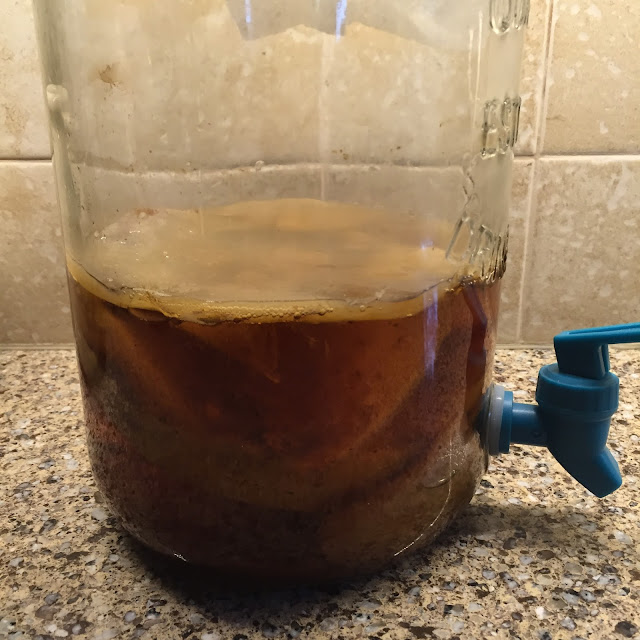The newest member of the market, and who is assigned the space next to us, is named Susan. Susan is an auditor for the state, but she enjoys gardening, enough so that she has extra to sell. She joined the market this spring and, like us, does not use any pesticides in her garden. So, we hit it off right away.
A few weeks ago she brought a jar of kombucha to the market and was giving out samples. This was my first introduction to this strange drink. If you have never heard of this, it is fermented tea. Yes, you read that correctly.....TEA. I was intrigued and she offered to give me the jar she brought to the market as a starter so I could begin brewing my own. Here's what she gave me.
The layer of material on top is called a SCOBY (Symbiotic Colony of Bacteria and Yeast), also known as a mother. It is a rubbery disk that floats on top of the tea as it ferments and closely resembles a byproduct of vinegar-making, also called a mother. The fact that both kombucha and vinegar produce similar mothers should give you a clue about how kombucha tastes. Once it is brewed, it has a tart and sour taste similar to vinegar, but it is also fizzy and, depending on how much sugar you add, slightly sweet, as well.
The SCOBYs form in layers as the kombucha is fed. If you look closely, you can see older SCOBYs in the bottom of the jar. But, I am getting ahead of myself. So, let me go back and explain how I started my own kombucha.
I bought a gallon-sized jar with a spout, organic sugar and loose-leafed tea.
I took the SCOBYs out of the jar and reserved a cup of the kombucha. I saved a couple of the SCOBYs in the rest of the kombucha in case I messed up and needed an extra one to start over.
Next, I brewed 4 cups of strong tea, to which I added 1 cup of sugar. When this cooled to room temperature, I added it to the jar I had purchased (having washed the jar in the dishwasher first) along with a couple of cups of plain water. The water you use should be non-chlorinated. Then, I added the reserved cup of kombucha from the original batch.
Next, I peeled off one of the SCOBYs and added it to the jar.
At this point, it had to sit for a week at room temperature while the mixture fermented. It was obvious when fermentation started because bubbles began forming and rising to the top. Also, a new SCOBY began to form on top.
After a week, I tasted it. It was okay and may have been fine for some folks, but I decided I wanted it a little stronger, so I let it sit a few days longer. In the mean time, I bought another jar and divided the mixture in half. To one half, I added 2 cups of tea, 1/2 cup of sugar and one of the extra SCOBYs I saved. I began using the other half, drinking only small amounts each day....about 4 ounces. How do you like my glass?
So, now I have 2 batches of kombucha going. One is brewing, while I am drinking on the other one.
I am now doing what is called "continuous brew" meaning that I just keep adding sweetened tea every week to one jar, while I drink from the other jar. However, at any point, I could brew a "batch" in the same manner that I did to begin with.
As you can see in the picture below, several layers of SCOBYs have formed and the bubbles indicate active fermentation. Eventually, I will have to divide the SCOBYs and dispose of the older ones, either by feeding them to the chickens or giving them away to friends who want to make their own kombucha.
Kombucha is touted as having healing properties, but like any ferment it contains living bacterial cultures that may or may not agree with you. So, it is best to start with small servings and see how it affects you. The healing properties of kombucha may be attributed to the fact that it contains glucuronic acid, a compound produced by our livers which binds with various toxins for elimination.
If you are interested learning more about kombucha, you can find a lot of good information on the internet. Here's a site with great information: Kombucha Kamp. Also, The Art of Fermentation by Sandor Katz is an excellent reference book on, not only kombucha, but all kinds of foods made using fermentation, as well.
And, if you need a SCOBY to get you started, I have a bunch of them!









Thanks for introducing kombucha to your readers. I have been brewing kombucha in Stillwater for quite a while. It is great way to cleanse all the toxins and combat bad bacteria. Since I have been consuming on a regular basis my overall wellness has greatly improved...naturally!
ReplyDelete